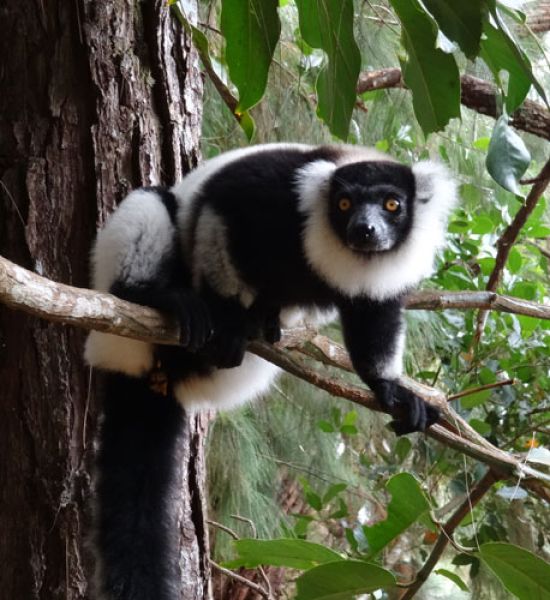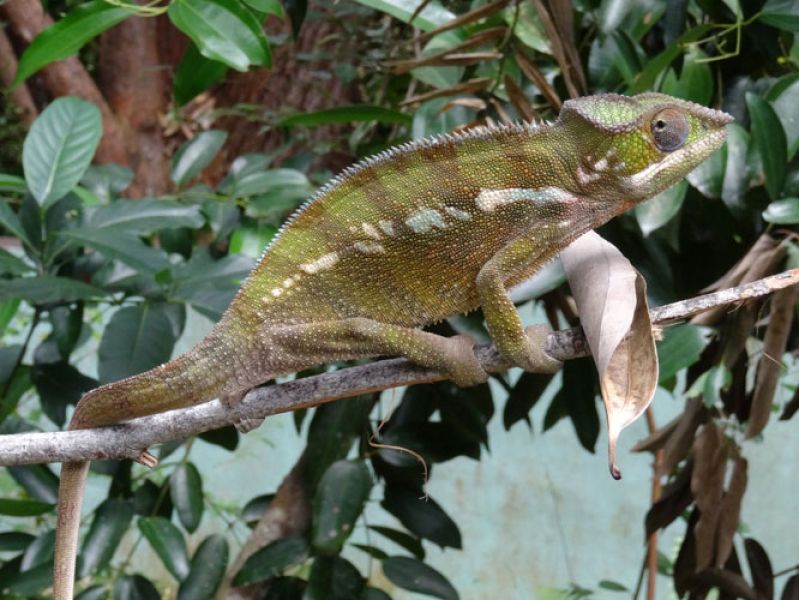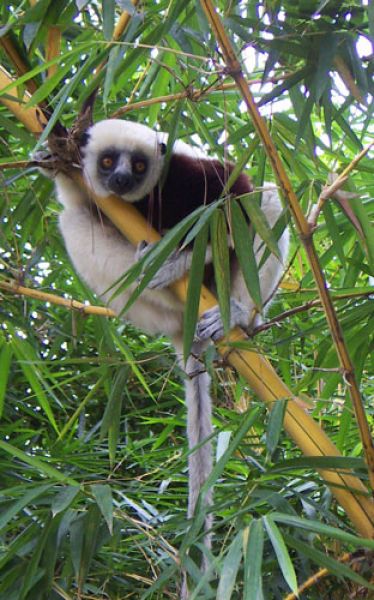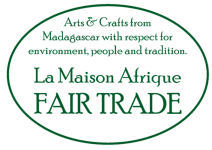Fair Trade crafts for Sustainable Development
Fair Trade is a good tool for Sustainable Development. The 10 principles for Fair Trade reflects the ecological-social-economic aspects of Sustainable Development. Crafts can meet high ecological criteria e.g. materials and production, high social standards e.g. gender equality, high economic standards e.g. value added.
Madagascar has one of the world’s highest percentage of extreme poverty (77,4 %). At the same time, it has a rich and unique flora and fauna to preserve. Madagascar is one of the world’s “biodiversity hotspots”. In this context, Fair Trade crafts stands out as an exceptionally good choice.
-
Sustainable development - definition
"Sustainable development is a development that meets the needs of today without compromising the ability of future generations to meet their needs."
Bruntland Report, 1987Sustainable development has been defined in many ways, but the most common citation definition is from the "Brundtland Report", a report written by the World Commission on Environment and Development on behalf of the United Nations in 1987. The report's title: ”Report of the World Commission on Environment and Development: Our Common Future”
-
Sustainable development - models
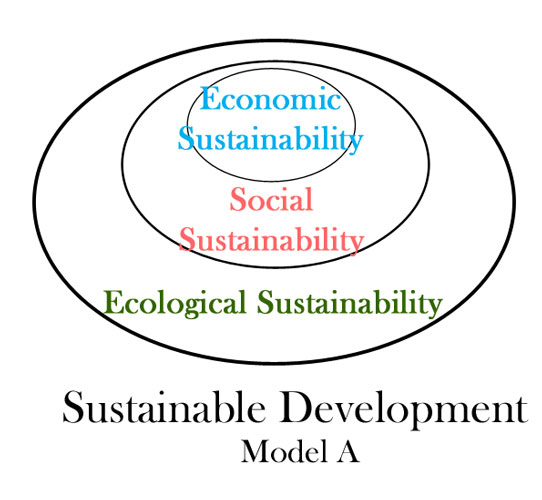
Model A
The three dimensions (ecological, social, economic) of Sustainable Development can be visualized as three circles where ecological sustainability constitutes the outer limit of what is possible. The three circles can alternatively be placed on top of each other in a hierarchy, where ecological sustainability forms the foundation for the social and economic.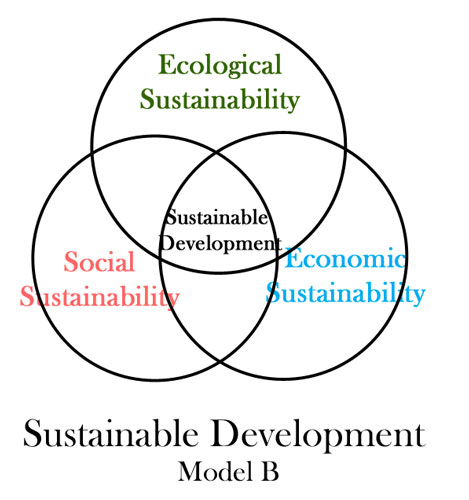
Model B
The three dimensions (ecological, social, economic) of Sustainable Development can be visualized as three circles that partially overlap. This model conveys an image of sustainable development where all three dimensions are not only needed, but also given equal weight and value. -
Agenda 2030 for the Sustainable Development Goals
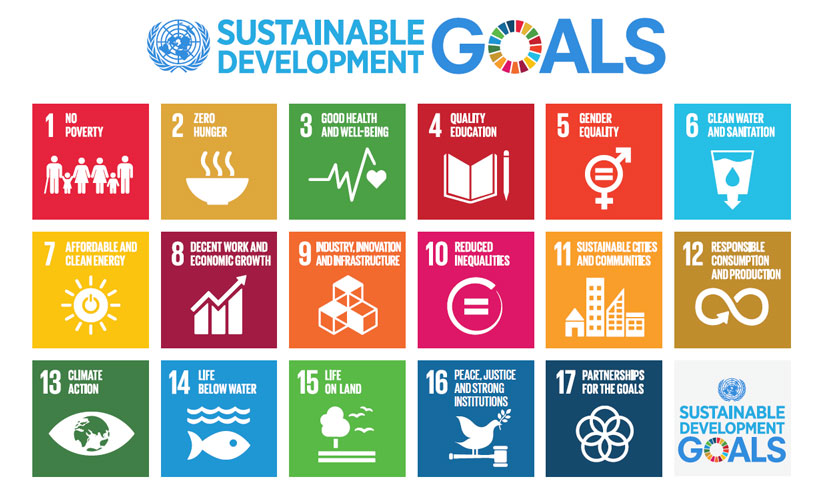
Sustainability is the basis of today's leading global framework for international cooperation: Agenda 2030 for Sustainable Development Goals (SDGs).
It was at the UN summit on 25-27 September 2015 that world leaders set the 17 global goals for Sustainable Development for the period up to 2030.
The 17 Goals for Sustainable Development are:
1.No Poverty
2.Zero Hunger
3. Good Health and Well-being
4. Quality Education
5. Gender Equality
6. Clean Water and Sanitation
7. Affordable and Clean Energy
8. Decent Work and Economic Growth
9. Industry, Innovation and Infrastructure
10. Reduced Inequality
11. Sustainable Cities and Communities
12. Responsible Consumption and Production
13. Climate Action
14. Life Below Water
15. Life on Land
16. Peace and Justice Strong Institutions
17. Partnerships to achieve the Goal“LEAVE NO ONE BEHIND.”
The defining principle of the Global Goals and Agenda 2030 is a joint pledge by every country to work together to ensure the rights and well-being of all on a healthy, prosperous planet.
But where do we stand halfway to 2030?
The UN writes in its "Sustainable Development Goals Report 2023" that it is time to sound the alarm: Halfway through 2030, the Sustainable Development Goals are in deep trouble. An assessment of approximately 140 goals shows that approximately half of the goals are moderately or seriously off track and for over 30 percent the situation is unchanged or worsened compared to 2015. Only for 15 percent of the 140 goals is the goal fulfillment in 2023 satisfactory. -
Fair Trade is a good tool for sustainable development.
For example, Fair Trade principle number 1 is “Creating opportunities for economically marginalized producers”. It is perfectly in line with SDG number 1 No poverty. Fair Trade principle number 10”Respect for the environment” reflects SDG 12 Responsible consumption and production, 13 Climate action and 15 Life on land. Another example is Fair Trade principle number 6, which is reflected by SDG 5 Gender equality. Finally, Fair Trade practice in its daily work and at grass root level SDG 17: Partnership for the goals.
The 10 principles of Fair Trade lead the work of Fair Trade organizations such as La Maison Afrique FAIR TRADE. They are principles that have been worked out for many years within the international Fair Trade movement.
-
The 10 principles for Fair Trade are
1. Creating Opportunities for Economically Disadvantaged Producers
2. Transparency and Accountability
3. Fair Trading Practices
4. Payment of a Fair Price
5. Ensuring no Child Labour and Forced Labour
6. Commitment to non-Discrimination, Gender Equity and Freedom of Association
7. Ensuring good Working Conditions
8. Providing Capacity Building
9. Promoting Fair Trade
10. Respect for the Environment -
Global Sustainable Development - demands engagement for global fairness
In its report “Poverty and Shared Prosperity 2020” the World Bank writes that the number of people living in extreme poverty (below the International Poverty Line USD 1,9 a day) decreased from 1.9 billion in 1990 to 741 million in 2015 and further to 689 million 2017. Yet the number of people living in extreme poverty remains unacceptably high and there are several reasons to believe that the SDG target of reducing the share of people living in extreme poverty to below 3 % by 2030 will not be achieved. In fact, the number of people living in extreme poverty in Sub-Saharan Africa rose from 284 million in 1990 to 431 million in 2017. Extreme poverty rate remains on average above 40 % in the region. Madagascar is the country in the world that, according to the report and also World Bank's Poverty data 2020, has the largest share (77.4%) of the population in extreme poverty.
In its report "Country Private Sector Diagnostic: Creating Markets in Madagascar for Inclusive Growth" presented 7th of December 2021, the World Bank Group notes that the covid-19 crisis has taken a heavy toll on Madagascar's economy. The crisis has hit the vast majority (94%) working in the informal sector the hardest, but has also led to unemployment in the apparel industry and tourism. In addition, the rural population (which makes up 80% of the country's population) is increasingly affected by climate change - related natural disasters: droughts, cyclones, floods. 2021 is the fourth year of drought and increasingly severe famine in southern Madagascar. As a result of these crises, extreme poverty in Madagascar is estimated to have increased to 79.7% of the population by 2020.
-
The year 2022 has begun with Madagascar being hit by two cyclones and two tropical storms in a month
January 22 tropical storm Ana, February 5 cyclone Batsirai, February 15 tropical storm Dumako and February 21 cyclone Emnati. Storms and cyclones that have caused important losses in human lives, destroyed homes and infrastructure. "Even though it is a cyclonic season in the Indian Ocean, it is rare to see four storms hit the same country within four weeks," said Clare Nullis of the World Meteorological Organization (WMO) in the UN article, which also reminds of perennial drought for some time back causes famine in the southern part of the country.
Madagascar has repeatedly been hit by political crises and severe cyclones. The combination has had a major impact on the economy as a whole and perhaps worst for the already poorest and most marginalized in society. Poor infrastructure, e.g. roads and electricity supply, is a result of political instability, natural disasters, widespread poverty. At the same time, Madagascar's poor infrastructure is a major obstacle to inclusive economic growth. More about that in the World bank group report 2021 mentioned above and e.g: In the Africa Competitiveness Report 2017, Madagascar has the bottom rank (ranked 138 out of 138 countries included) regarding road quality. In the World Bank report "Doing Business Madagascar 2020", Madagascar is ranked close to the bottom (186 out of 190 counted countries) regarding access to electricity. The country is ranked 161 when the assessment includes all ten indicators of the report on how difficult or easy it is to start and run a company there.
The World Bank's Madagascar overview dated 7 October 2022 reports that the proportion of Madagascar's population living in extreme poverty has increased further (to 81%) and so has also the number of people affected by famine or malnutrition.
-
At the same time, Madagascar has one of the richest and most unique flora and fauna in the world to preserve
Madagascar is, together with the smaller surrounding islands, one of the world’s “biodiversity hotspots”. Here below some figures to describe an immeasurable great value.
-
EndemismMadagascar and the surrounding islands has an extremely high floral and faunal endemism.
-
PlantsThe threshold of endemism for a region to qualify as biodiversity hotspot is 1500 endemic plants; the Madagascar flora alone comprises about 10 000 endemic species. For palm trees (Arecaceae), Madagascar is considered as one of the world’s richest places. The wealth is mainly characterised by endemism close to 100 %.
-
Regarding fauna, the level of species endemism is exceptional.
-
Mammals
Of the approx. 211 indigenous species of terrestrial mammals, 95% are endemic. Lemurs, which are endemic to Madagascar, are considered the world's oldest primates. The history of lemurs begins over 70 million years ago, when lemur-like animals roamed Africa alongside the dinosaurs. Scientists believe that about 65 million years ago, lemurs made their way across the water to the island of Madagascar on floating vegetation. Over the next tens of millions of years, the lemurs of Madagascar evolved and diversified into the 112 species we see today. The smallest of the lemur species is Madame Berthe's mouse lemur (Microcebus berthae), which has an average body weight of 30 grams is also the world's smallest primate. The largest of the lemur species is Indri (Indri indri), which weighs around 6-9.5 kg.
With 112 species of endemic lemurs divided into five families and 14 genera, Madagascar has the world's greatest primate biodiversity. (Brazil, which has 77 species but only two endemic genera and no endemic families, is second). Lemurs are fascinating creatures, but a recent update to the IUCN Red List showed that 98% of lemur species are threatened with extinction.
-
Madagascar carnivores
Eupleridae is a family of carnivores endemic to Madagascar, comprising 10 known living species in seven genera. (That these animals form their own systematic group was only discovered after genetic studies and previously most of the species were placed in the viverrid or mongoose families.) The best known of the species is the fossa (Cryptoprocta ferox). Fossa is the largest carnivore among the endemic mammals of Madagascar. Resembling a small cougar or slender, long-tailed cat. Adults have a main body length of 70–80 cm and weigh between 5.5 and 8.6 kg, with males larger than females. The fossa has semi-retractable claws (meaning it can extend but not fully retract the claws) and flexible ankle joints that allow it to climb up and down trees head first, and also support jumping from tree to tree.
Cryptoprocta ferox was assessed for the IUCN Red List of Threatened Species in 2015 and is listed as Vulnerable (VU).
-
Birds
Madagascar and the surrounding islands avifauna is characterised by low diversity but spectacular specific endemism; of the 503 species found in the hotspot, nearly 60% are found nowhere else on the planet.
-
Reptiles
The diversity (+457 species) and endemism (96%) of reptiles is high. The region is a major center of diversity for chameleons, with dozens of species on Madagascar. Current examples are that in 2021, the world's smallest reptile to date (the chameleon Brookesia nana) was identified in northern Madagascar. Males of the species Brookesi nana measure 21.6 mm from snout including tail, females 28.9 mm. In the year 2022, researchers investigating the same region in northern Madagascar have identified eight new species of miniature geckos within the Lygodactylus madagascariensis group.
-
Amphibians
The specific amphibian endemism in the region is extraordinary, with only one species out of 309 identified that is not endemic to the hotspot. Endemism is 99,7%.
-
In addition to the above mentioned, the hotspot includes a wealth of endemic freshwater fish, invertebrates and has an impressive marine biodiversity: fishes, marine turtles and marine mammals.
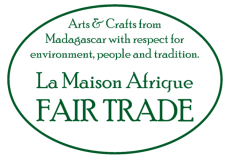
La Maison Afrique FAIR TRADE
-
+46 (0) 706017777
-
This email address is being protected from spambots. You need JavaScript enabled to view it. -
Trustorps Gård
311 65 Vessigebro
SVERIGE -
VAT/Orgnr: SE556526323201


